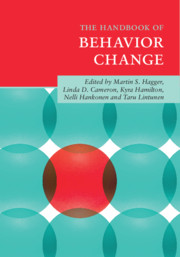Book contents
- The Handbook of Behavior Change
- The Handbook of Behavior Change
- Copyright page
- Dedication
- Contents
- Figures
- Tables
- Sidebars
- Contributors
- 1 Changing Behavior: A Theory- and Evidence-Based Approach
- Part I Theory and Behavior Change
- 2 Changing Behavior Using the Theory of Planned Behavior
- 3 Changing Behavior Using Social Cognitive Theory
- 4 Changing Behavior Using the Health Belief Model and Protection Motivation Theory
- 5 Changing Behavior Using the Common-Sense Model of Self-Regulation
- 6 Changing Behavior Using the Model of Action Phases
- 7 Changing Behavior Using the Health Action Process Approach
- 8 Changing Behavior Using Self-Determination Theory
- 9 Changing Behavior Using Control Theory
- 10 Changing Behavior Using the Transtheoretical Model
- 11 Changing Behavior Using Integrative Self-Control Theory
- 12 Changing Behavior Using the Reflective-Impulsive Model
- 13 Changing Behavior Using Habit Theory
- 14 Changing Behavior by Changing Environments
- 15 Changing Behavior Using Integrated Theories
- 16 Changing Behavior Using Social Identity Processes
- 17 Changing Behavior Using Ecological Models
- 18 Changing Behavior Using Theories at the Interpersonal, Organizational, Community, and Societal Levels
- Part II Methods and Processes of Behavior Change: Intervention Development, Application, and Translation
- Part III Behavior Change Interventions: Practical Guides to Behavior Change
- Index
- References
11 - Changing Behavior Using Integrative Self-Control Theory
from Part I - Theory and Behavior Change
Published online by Cambridge University Press: 04 July 2020
- The Handbook of Behavior Change
- The Handbook of Behavior Change
- Copyright page
- Dedication
- Contents
- Figures
- Tables
- Sidebars
- Contributors
- 1 Changing Behavior: A Theory- and Evidence-Based Approach
- Part I Theory and Behavior Change
- 2 Changing Behavior Using the Theory of Planned Behavior
- 3 Changing Behavior Using Social Cognitive Theory
- 4 Changing Behavior Using the Health Belief Model and Protection Motivation Theory
- 5 Changing Behavior Using the Common-Sense Model of Self-Regulation
- 6 Changing Behavior Using the Model of Action Phases
- 7 Changing Behavior Using the Health Action Process Approach
- 8 Changing Behavior Using Self-Determination Theory
- 9 Changing Behavior Using Control Theory
- 10 Changing Behavior Using the Transtheoretical Model
- 11 Changing Behavior Using Integrative Self-Control Theory
- 12 Changing Behavior Using the Reflective-Impulsive Model
- 13 Changing Behavior Using Habit Theory
- 14 Changing Behavior by Changing Environments
- 15 Changing Behavior Using Integrated Theories
- 16 Changing Behavior Using Social Identity Processes
- 17 Changing Behavior Using Ecological Models
- 18 Changing Behavior Using Theories at the Interpersonal, Organizational, Community, and Societal Levels
- Part II Methods and Processes of Behavior Change: Intervention Development, Application, and Translation
- Part III Behavior Change Interventions: Practical Guides to Behavior Change
- Index
- References
Summary
Self-control problems are ubiquitous and a frequent target of behavior change interventions. From a theoretical perspective, self-control is not a unitary phenomenon but rather encompasses a vast and complex set of interacting aspects or key components. As the science of self-control keeps growing, the integration of these key components becomes increasingly important. To this end, an integrative self-control theory (integrative self-control theory) is proposed – a mid-level theory that connects seven psychological components or “hubs” of self-control: (1) desire; (2) self-control goal; (3) self-control conflict; (4) self-control motivation; (5) self-control capacity; (6) self-control effort; and (7) constraints. This chapter addresses the issue of behavior change from the perspective of this integrative theory of self-control. A brief introduction to the theory is followed by demonstrations on how it can be used to identify and classify various behavior change techniques in the self-control domain. Moreover, differences and similarities of integrative self-control theory next to more general frameworks such as the commitment-opportunity-motivation behavior model (Michie, Atkins, & West, 2014) are outlined, avenues for future research highlighted, and general recommendations for behavior change from the perspective integrative self-control theory provided.
Keywords
- Type
- Chapter
- Information
- The Handbook of Behavior Change , pp. 150 - 163Publisher: Cambridge University PressPrint publication year: 2020

